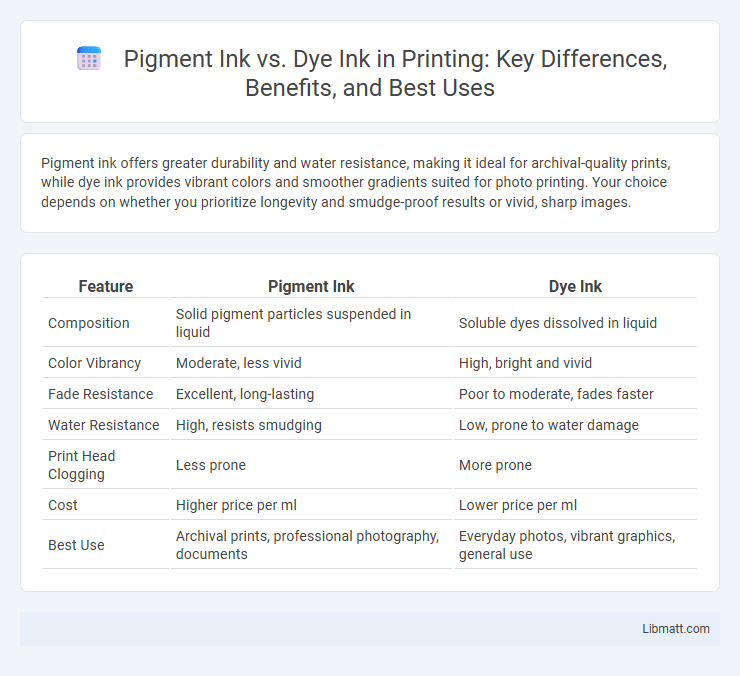Pigment ink offers greater durability and water resistance, making it ideal for archival-quality prints, while dye ink provides vibrant colors and smoother gradients suited for photo printing. Your choice depends on whether you prioritize longevity and smudge-proof results or vivid, sharp images.
Table of Comparison
| Feature | Pigment Ink | Dye Ink |
|---|---|---|
| Composition | Solid pigment particles suspended in liquid | Soluble dyes dissolved in liquid |
| Color Vibrancy | Moderate, less vivid | High, bright and vivid |
| Fade Resistance | Excellent, long-lasting | Poor to moderate, fades faster |
| Water Resistance | High, resists smudging | Low, prone to water damage |
| Print Head Clogging | Less prone | More prone |
| Cost | Higher price per ml | Lower price per ml |
| Best Use | Archival prints, professional photography, documents | Everyday photos, vibrant graphics, general use |
Introduction to Pigment Ink and Dye Ink
Pigment ink consists of tiny solid particles suspended in a liquid carrier, offering better water and light resistance for long-lasting prints. Dye ink is composed of colorants dissolved in a liquid, producing vibrant, high-saturation colors ideal for photo printing. Your choice between pigment and dye ink depends on whether you prioritize durability or color vibrancy in your prints.
Composition and Chemical Differences
Pigment ink contains solid color particles suspended in a liquid carrier, offering water-resistant and fade-resistant properties due to the larger particle size and chemical stability. Dye ink is composed of colorant molecules fully dissolved in a liquid solvent, resulting in vibrant colors but with less resistance to water and fading. Your choice depends on print durability needs, as pigment inks excel in longevity while dye inks provide brighter, more vivid prints.
Color Vibrancy and Print Quality
Pigment ink offers superior color vibrancy and print quality due to its lightfast properties, ensuring colors remain vivid and sharp over time without fading. Dye ink produces more saturated colors with a glossy finish but is prone to bleeding and quicker fading under exposure to light. For durable prints with consistent sharpness and resistance to water and UV damage, pigment ink is the preferred choice in professional and archival printing.
Water and Light Resistance
Pigment ink offers superior water and light resistance compared to dye ink due to its larger, insoluble particles that adhere to paper surfaces without dissolving. Dye ink penetrates paper fibers, resulting in vibrant colors but lower durability when exposed to moisture or UV light. For archival-quality prints or outdoor use, pigment ink is the preferred choice because it maintains color integrity over time and under harsh conditions.
Longevity and Fade Resistance
Pigment ink offers superior longevity and fade resistance compared to dye ink, making it ideal for archival-quality prints and outdoor use. Its larger pigment particles sit on the paper surface, providing enhanced durability against UV light and moisture. Your prints will maintain vibrant colors and sharp details for decades without significant fading when using pigment ink.
Printing Applications and Best Uses
Pigment ink excels in printing applications requiring durability and water resistance, such as archival documents, fine art prints, and outdoor signage, due to its larger particle size and lightfast properties. Dye ink is best suited for vibrant color reproduction in photo printing, marketing materials, and everyday home or office use, offering superior color richness and smooth gradients but less resistance to fading. Choosing between pigment and dye ink depends on the need for longevity versus color vibrancy in specific print projects.
Compatibility with Printers and Papers
Pigment ink is highly compatible with a wide range of printers, especially those designed for professional photo and fine art printing, and adheres well to various paper types including glossy, matte, and textured surfaces without bleeding. Dye ink is primarily compatible with standard inkjet printers and works best on coated papers where it can absorb quickly, producing vibrant colors but often prone to smudging on uncoated papers. Printer manufacturers often specify ink compatibility to optimize print quality and longevity, making it essential to match ink types with both printer models and paper stocks for optimal results.
Cost Comparison and Affordability
Pigment ink cartridges generally cost more upfront than dye ink cartridges due to their complex manufacturing process, but they offer better longevity and resistance to fading, making them more cost-effective over time. Dye ink cartridges are more affordable initially and widely available, yet they tend to require more frequent replacement because the ink can fade or smudge faster. Budget-conscious users seeking affordable print solutions often prefer dye ink, while those needing durable, high-quality prints may find pigment ink to be a more economical choice in the long run.
Environmental Impact and Safety
Pigment ink contains larger particles that are less likely to wash away, reducing water pollution and offering greater environmental safety compared to dye ink, which dissolves and can contribute to chemical runoff. Pigment inks are often made with non-toxic materials, making them a safer choice for your health and for the environment during disposal. Choosing pigment ink over dye ink supports sustainability by minimizing harmful chemical exposure and enhancing long-term ink stability.
Choosing the Right Ink for Your Needs
Pigment ink offers superior longevity and water resistance, making it ideal for archival prints, professional photography, and documents requiring durability. Dye ink provides vibrant colors and smoother gradients, perfect for everyday photo printing and general-purpose use. Assess printing needs based on color vibrancy, fade resistance, and specific media compatibility to choose the right ink type.
Pigment ink vs dye ink Infographic

 libmatt.com
libmatt.com